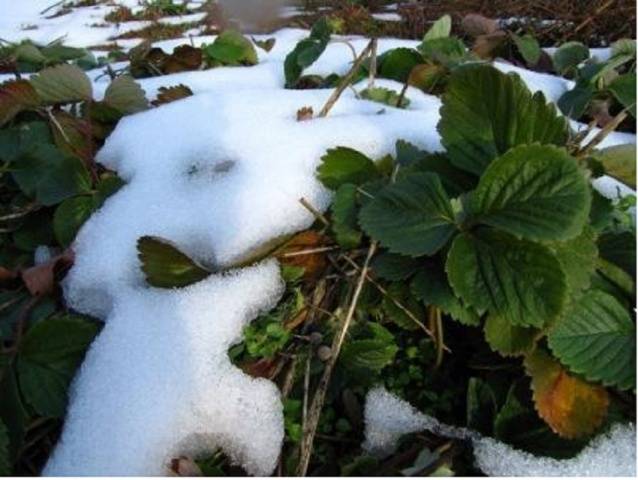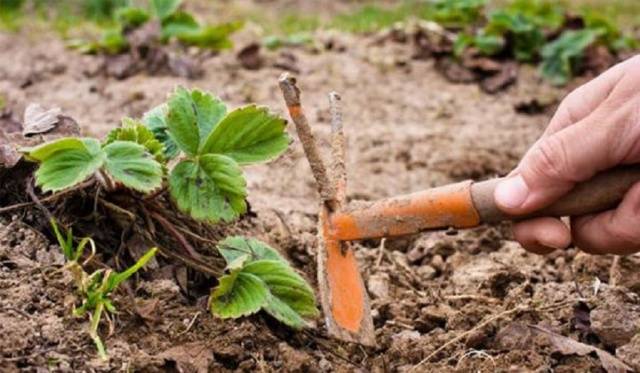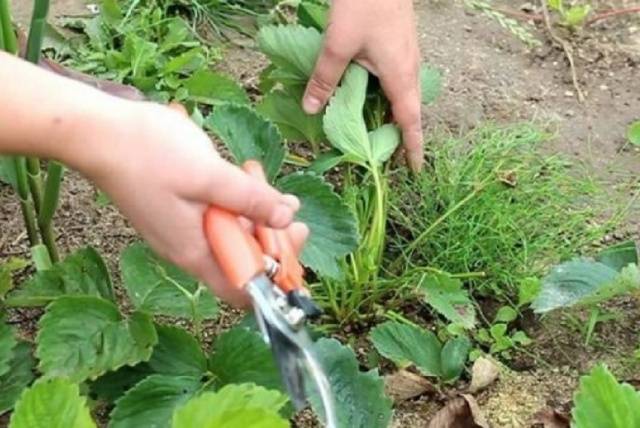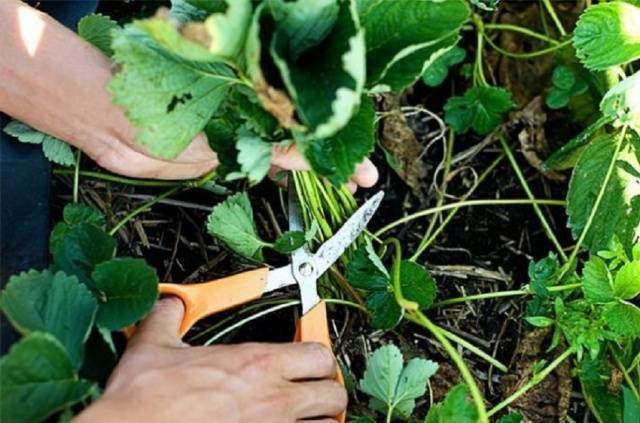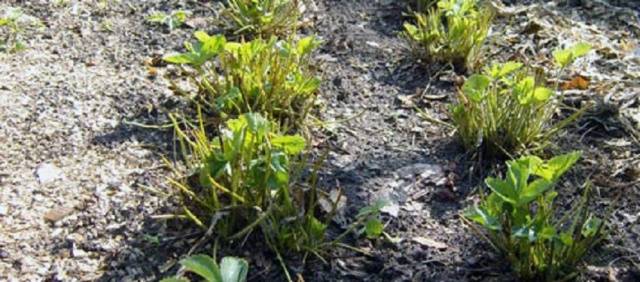Content
At each summer cottage, gardeners are trying to allocate space for strawberry ridges. It is very important for beginners to know the nuances of growing sweet berries. Therefore, one of the stages that gardeners are interested in is pruning strawberries in the fall. This is due to the fact that there is no consensus on this topic yet. Some summer residents believe that pruning strawberries after harvesting is very useful for the plant, others do not see much sense in this.
The optimal solution for doubting garden strawberry lovers would be to separate the agricultural machinery of the ridges. On some it is worthwhile to carry out the autumn pruning, while others should be left unchanged. And then decide if pruning matters strawberry leaf, and whether it is necessary to subject the plant to this procedure annually.
Feasibility of pruning strawberry bushes
To decide whether or not to prune strawberry leaves after harvest, consider the arguments of opponents and supporters of the method.
Those who deny the need for pruning believe that:
- Leaves are needed for photosynthesis and removal reduces the ability of the bushes to "breathe". Therefore, preparing for the winter for the plant becomes more difficult.
- Pruning for pest control will not work. They calmly remain in the soil and on its surface, then move to new leaves.
- There is a possibility of damage to the generative and vegetative buds on the bush, which will lead to a decrease in yield for the next year.
- Pruning strawberries for the winter causes stress on the plant, which slows down the growth and formation of berries on the strawberry bushes.
The arguments of the supporters of pruning are as follows:
- Pruning is very helpful, especially if there are signs of disease on the bushes. This will prevent the spread of the disease. Once the crop is harvested, after three weeks the leaves are removed and the plants are disinfected and fed.
- After fruiting, the old foliage gradually dies off and becomes useless. Photosynthesis takes place in new young leaves, while fruit buds are laid for the next year. Autumn pruning makes it possible to take care of the future harvest in advance.
- After pruning strawberries, the resistance of the bushes to cold increases. The procedure helps plants to overwinter and maintain the ability to bear fruit for the next year. This can be easily checked in areas where strawberry planting is divided according to agronomic measures. Compare the condition of the bushes with and without trimmed leaves during the cold snap.
- Any rejuvenation of the bush is a plus. At this point, the roots are strengthened, because nutrients do not enter the leaves, but remain in the root system.
- Pruning will not bring much harm, because the reproduction of garden strawberries occurs with a mustache.
The rest of the agrotechnical measures (preventive spraying, loosening, feeding) you will do regardless of whether you trim the strawberries after fruiting or not. Caring for strawberries after harvest also requires adherence to certain rules.
Pruning strawberries in fall without mistakes
To ensure that the entire pruning process runs harmoniously and without problems, you should not experiment. Many gardeners grow garden strawberries and willingly share their experiences. Therefore, the implementation of the recommendations will provide a good result and a minimum of hassle.
Before you start pruning strawberries in the fall, give your full attention to harvesting.
The next step is to clear the ridges of debris, weeds and loosen.
Then assess the condition of the strawberry bushes.It includes:
- the degree of growth of the bushes during the fruiting period;
- the number of dry and damaged leaves on the bush;
- the presence of diseases and pests;
- analysis of the yield of varieties;
- necessity transplanting garden strawberries to a new place of residence.
The full amount of information will allow you to trim correctly. The optimal timing for this event is late August or early September. It depends on the fruiting period of the varieties, climatic conditions and does not apply to remontant strawberries.
What to focus on when pruning strawberries after fruiting?
First of all, on the correctness of the operation itself. Cut the strawberries to meet certain requirements. For this:
- Stock up on a sharp garden tool. Pruning shears, scissors or a garden knife will work. The sharper the tool is, the less damage you can do to the strawberry bush.
- Cut off only leaf blades. Leave petioles up to 10 cm in size on the bush. So, you will reliably protect the growing point of strawberries from damage and preserve the future harvest of sweet berries.
Along with pruning the leaves, take care of the mustache. If you need a shrub to propagate, keep the first outlet. Remove the rest of the whiskers so that the plant does not waste its energy on them. If breeding a bush is not part of your plans, delete everything. Cut the mustache at the root, it is highly undesirable to cut them off with your hands. You can damage the bush and its roots.
The main stages of caring for strawberries after autumn pruning
After trimming the strawberry leaves, water the plants and gently loosen the soil around the bush. The depth of loosening should be at least 10 cm. In order not to damage the roots, loosen the aisles.
The next step will be watering with a solution of potassium permanganate. If there are signs of disease or damage on the strawberry bushes, you will have to add treatment with Bordeaux mixture or another fungicide.
After an important autumn event for the growth and development of strawberries, it is necessary to feed the bushes. Gardeners use various substances:
- dry manure;
- mature compost;
- wood ash (not combined with fresh manure);
- biohumus;
- any complex mineral composition;
- ammophoska.
Experienced gardeners advise feeding the strawberry bed at least three times after pruning. First, liquid nitrogen fertilizers are applied immediately after the autumn rejuvenation of strawberries.
The second feeding is carried out two weeks later with a mixture of organic matter, phosphorus and potassium.
For the third time, strawberries are fed in mid-September with mullein solution or compost infusion.
Watering is also important during this period. Moisten the ridges every other day. Regularity will help young foliage grow faster and protect strawberries from frost.
Summer residents who do this procedure annually can say with confidence that even novice gardeners can handle the strawberry pruning scheme. And it is much easier to care for garden strawberries after pruning.
And for whom pruning strawberries is difficult, a video of experienced gardeners will be a good help:
In addition, listen to the advice of experienced summer residents.
Useful tips for gardeners on pruning strawberries in the fall
You should not be rigidly attached to deadlines. It is important that the strawberries stop bearing fruit.
Choose a dry, but not hot, day for pruning. Best of all, schedule the procedure in the morning or evening so that direct sunlight does not injure the strawberry bushes. A rainy day is also not a good choice. You will have a harder time pruning well, and moisture will help fungal infections spread quickly.
It is important to preserve the base of the bush, which will enable new shoots to form.
If strawberry bushes have time to build up a leaf mass before the onset of cold weather, then they are not afraid of winter. For reliability, cover the ridges with spruce branches, spunbond or other covering material.
For beginner gardeners, it is very useful to watch a video of strawberry trimming:
or
So, it is easier to understand the pruning technique and notice useful nuances.
After completing a qualitatively useful procedure, you can keep your favorite sweet berry variety and ensure yourself a decent harvest for the next year.
